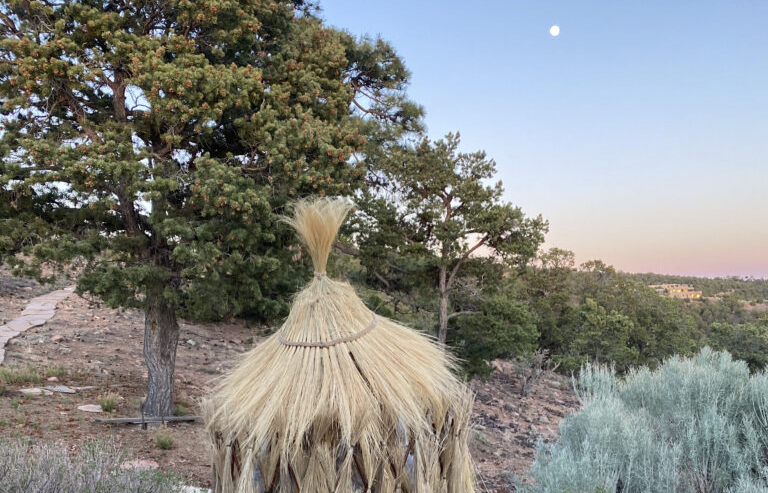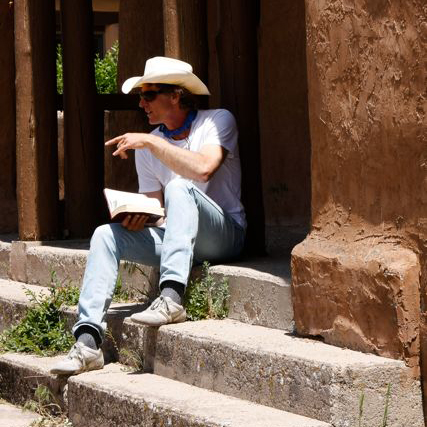
Shrub Costume
Costume was created by Open Channel Content.

Costume was created by Open Channel Content.
With but one class in jewelry making under my belt, I began fabricating jewelry for Heather Laurie and her partner Phoenix Sun in 1990. After working for them for three years, I became a full-time designer and partner in the business, “Heather and Phoenix,” a wholesale and retail art-to-wear jewelry studio.
In 1996, I created a new line of sterling silver, gold and semi-precious metal jewelry, named “Rio Plata” and began marketing at the same venues. In 1997 Phoenix and I bought out Heather Laurie and we carried on with that line of jewelry and fashion accessories under the new name of “Stryder and Phoenix.” Together we did as many as 30 juried art and trade shows per year and serviced dozens of wholesale accounts, nationwide, including Nordstroms and Henry Bendel. From 1990 until 2005, if we weren’t at a show, we were either getting ready for a show, on our way to a show, or getting back from one. Over that period of time, our work was viewed by millions of people and worn by thousands. We frequently won awards in juried shows, for our displays as well as our art. Our work could be spotted in the film “Waiting to Exhale,” and exclusive editions of our jewelry were sold in the Coldwater Creek catalog.
It was fun designing and even making the jewelry, but the small business aspect of it was a going. We had subcontractors and suppliers, inventory and huge customer databases. The economy was booming under Clinton. It’s the last time we had a budget surplus. It was also a time of easy credit so everybody had tons of plastic to max out. Creatively speaking, it was encouraging to see our work sell well, but I soon grew weary of talking about my occupation when I was a jeweler. I kept trying to get into a writing program or better yet, sell a manuscript. I couldn’t wait to say I was a writer, not a jeweler.
In Aspen in 1990-91, I was a part-time assistant director at Grassroots Television. We played over 80 hours of original programming per week, some of it live cast from our studio as well as remote broadcast events. It was just as digital was becoming a consumer medium. The station was the nation’s first public access television station. I first went in there because I heard you could check out a camera and learn the editing equipment and produce your own work for public broadcast. I made about 20 hours of my own material between 88 and 91. Some of it is archived and will eventually end up here. Some of it is embarrassing, but some of it was as satisfying as anything else I’ve attempted in art.
It was also at that time I worked at Sunfire Productions a full service film and video production company in Aspen/Basalt. Sequoia Sun was chief and I got a lot of experience thanks to him. He put me on jobs I might not have had the courage to attempt, if it weren’t for his sure guidance and willingness to take a risk. I’ll never forget skiing backwards down Ajax Mountain with a backpack full of batteries and a couple of cables to wrangle, that were connected to a camera on Sequoia’s shoulder. He too was skiing backwards, directly upslope of me, while videoing a famous mono skier, who was directly upslope of him, doing aerial tricks and a full-tilt mogul boogie, that we had been hired to shoot. Besides wild stunt videos, Sequoia produced commercials, covered conferences, made documentaries and we did occasional weddings, too.
The decision to quit the television station was brought on, like so many of my creative pivots, by a physical need. Public television was notoriously under staffed. I’d go to work before sun up and not leave until sun down. In those days, there was so much equipment and cables, it was throwing off tremendous amounts of electricity that drained my energy. I would go home buzzing from being around all this highly juiced equipment all day. At about that time I was given the opportunity to join Heather and Phoenix on their jewelry line. That turned into a fifteen year detour from video production, but as the jewelry scene peaked, the prospect of making motion pictures became a fascination of mine, once again. By then, the digital revolution had evolved to where we are now. Most importantly, electromagnetic exposure is massively reduced with today’s production tools, so that could no longer discourage me from continuing to pursue that avenue of expression. Then one summer day in 2007, I saw a call for application to the free weekly for The New Mexico Filmmaker’s Intensive.
After film school, my partner and I envisioned opening up a boutique film production studio. It so happened in 2009, there were at least four other similar ventures freshly launched in this market. None of them remain open for business. Despite this, OCC has made some enjoyable videos, over these past dozen years. We have half a dozen brand new short videos for this section recorded, lined up to be edited and posted, as soon as we are able.

I wrote my first screenplay “Uncommon Bonds,” by candlelight, on a battery powered typewriter, while living in a 100- year-old miner’s cabin and being a carpenter during the day.
Upon completing my second feature length screenplay, “Coyote Paints the Town,” I submitted it and was admitted to the Aspen Screen and Play Writer’s Conference, with William Kelley (academy best screenplay co-winner for “Witness.”) With the personal encouragement of Mr. Kelley, I helped form the Aspen Screenwriter’s Roundtable and was a regular attendant until moving away in 93. In 94 I met crashed numerous parties at Telluride film festival 94, in an attempt to drum up interest in “Coyote Paints the Town.” This led to a look by Columbia Pictures. Later that year I pitched it to a development exec with ties to Warner Brothers. Both attempts stalled out and just left me hanging there wondering how to play in that world.
After numerous attempts, I grew disillusioned with trying to find a place in the movie business. At that same time, I was beginning to feel like 100 pages was a rather confining limit. I wanted more space for a story to stretch out and allow for deeper character development, subtler plot dynamics and loads more detail, of the kind I admired in the novels of Saul Bellow, Lawrance Durrell, Norman Mailer and Gore Vidal. I studied the collected works of women writers as well, beginning with Anais Nin, Isak Dinesen and Ursula Le Guin. The devotion to writing long form fiction took me on about a 20 year, three novel, detour before I got back down to the art of screenwriting.
In 2008 it was my pleasure to study the craft, four days a week for 9 months, with Tom Musca, of “Stand and Deliver” notoriety. Tom was adept at the art of story structure. In addition, I was able to attend a number of lectures and a screenwriter’s weekend with Emmy award winning writer-producer Kirk Ellis. A subsequent 10 year commitment to writing screenplays led to another bout of frustration with breaking into the industry. Each year, I would apply with a new original feature to Sundance Screenwriter’s lab. The best I could manage was a second round nod for my social drama, “fathersfailure.com.”
The best screenplays disappear from our attention, while they achieve an intricate clockwork of connections that turn simultaneously on every beat.
Ape Huchi Wacka Ush is an original song written and performed by Madi Sato. In it she honors her Ainu ancestors. Her performance, the setting, weather conditions and documentation all come together in this music video, which is the most recent OCC HD project. It has already been shared across the Pacific to the relatives in her Ainu homeland. Now we are applying to festivals.
The experience of making this movie was exceptionally rewarding. It began when cameraman Kevin Jones told us he was going to rent a Sony FS-7 and do some test shooting for a couple weeks. Fortunately, at that same time, our friend Madi had been recording her latest album. Rather casually, we dropped the suggestion to both parties that perhaps the timing is such that they could help each other out. Everyone was ready. It came so easy, like the planets were aligned for it.
Pre-production was minimal, consisting of a locations scouting session, a walk through and agreement to commence shooting the very images that Madi was dreaming up on the spot. So, contrary to the way we usually work, there was neither script nor storyboard in print when we commenced our two-and-a-half day shoot, up in the mountains in winter.
The simple premise of a medicine woman praying to her ancestor and her ancestor answering in a parallel dimension , was what we tried for. The ceremonial prayers, chants and gestures provide adequate content, and the humble grace of the celebrant is inspiring. Earth, wind, fire and water are the elementals through which this mysterious contact is transacted.
Frequent collaborator James Becker made his skills and experience available for assembling the footage, in-sync with Madi’s singing. In the process he also created a host of marvelous dissolves that convey the parallel universe perspective effectively.
David Jean Schweitzer was generous with his skills and experience in the fine cut and color grading. It was David that bore the majority of the brunt of our abbreviated pre-production period consequences. David has been a frequent OCC collaborator. We honor him for all his many contributions to our movies over the years.
Couple Studios in Boulder is another frequent collaborator. Ed Kaufman has engineered our final output to optimum industry standards with a personal touch that comes from long experience.
We look forward to its premiere at a film festival near you.